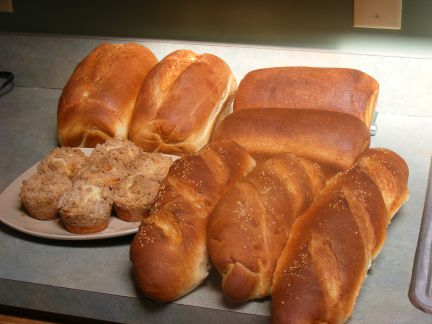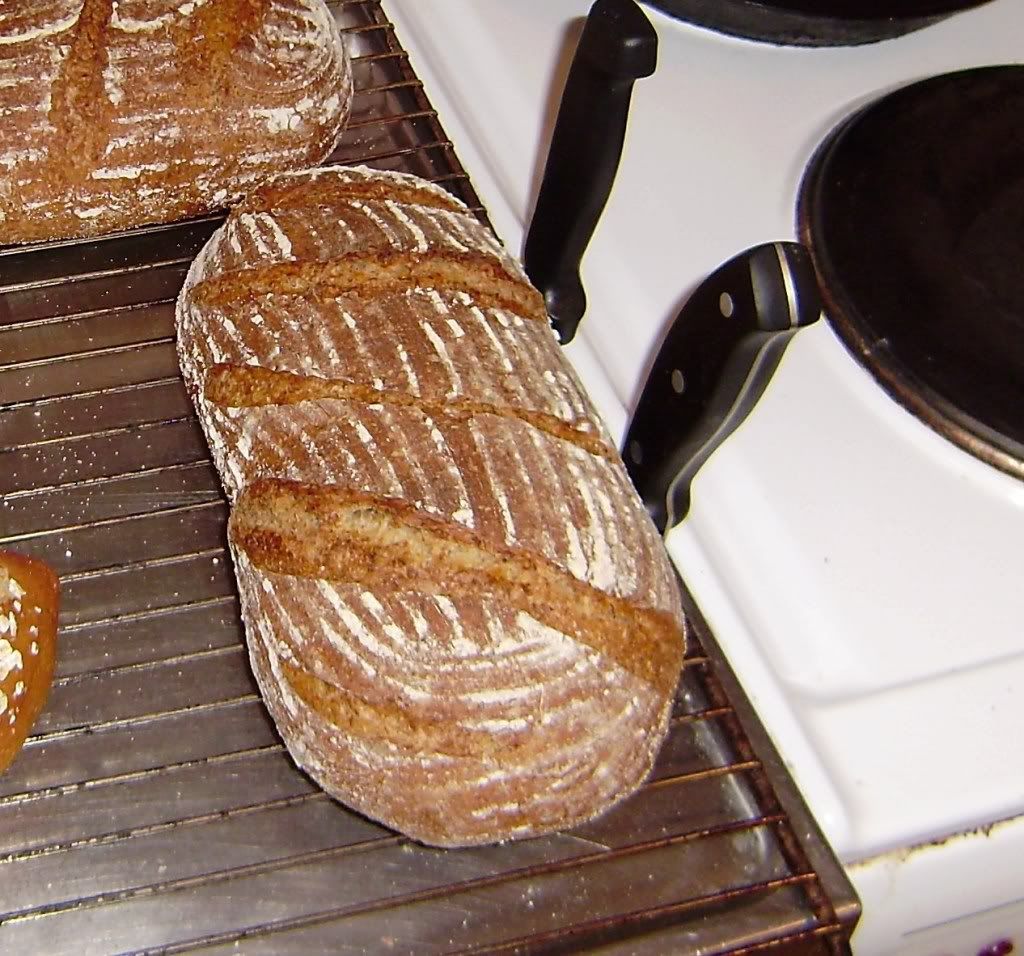
Pane di Genzano (the real thing)

Pane di Genzano

Pane di Genzano Crumb
In "Local Breads," Daniel Leader has 3 breads from Genzano, a village just outside Rome. Well, 2 breads and a pizza. The 2 breads are an all-white bread (Pane casareccio di Genzano) and one that uses half bread flour and half whole wheat (Pane lariano). Zolablue had written about these breads some time ago. (http://www.thefreshloaf.com/node/4417/genzano-country-bread-local-breads ) Hers were gorgeous and sounded delicious. But the recipe spooked me at the time. It is a huge loaf and a super-wet dough. Since then, I had gained some experience with slack doughs and felt up to trying one of the pane di Genzanos.
I'm not quite sure what to call the bread I made because I "split the difference" between the breads in the book. I used 25% whole wheat. I also did not follow Leader's instructions for mixing. I wanted to try the Hamelman folding technique on this bread, since I was so happy with how it had worked with my baguettes. I also wanted to try the "double hydration" technique recommended by Suas in "Advanced Bread and Pastry" for improved gluten development in slack doughs.
Formula
(I used my regular 75% hydration sourdough starter which is fed with 70% AP, 20% WW and 10% Rye for the biga).
Biga Naturale 368 gms
Water 405 gms
Bread Flour 375 gms
WW Flour 125 gms
Instant yeast 7 gms
Sea salt 14 gms
Unprocessed bran for sprinkling
Mixing
In the bowl of my KitchenAid mixer, I mixed 300 gms of water with the biga, then added the flours, yeast and salt and mixed with a rubber spatula until the ingredients were all incorporated in a shaggy mass.
I then mixed with the dough hook at Speed 4, with occasional bursts to Speed 6, for about 12-14 minutes. At this point, I had some gluten development, and the dough was clearing the sides of the bowl at Speed 4. I began slowly adding the remaining 100 gms of water, probably about 10-15 gms at a time, waiting for each addition to get incorporated before adding the next. I continued to mix at the same speed for another 10 minutes or so.
(Note: Leader's mixing instructions are to put all the ingredients in the bowl and stir together. Then mix at Speed 8 for 10 minutes or so, then at Speed 10 for another 10 minutes.)
Fermentation
I then transferred the dough to a 4 quart glass measuring pitcher. I had planned on fermenting the dough for 3 hours, doing stretch and folds after 60 and 120 minutes. The dough was overflowing the pitcher after 60 minutes. I transferred it to a 6 quart bowl, did my stretch and folds and covered the bowl. After 120 minutes, the dough had re-doubled and was extremely soft and puffy. The gluten was better developed. I did another series of stretches and folds and fermented another hour.
The dough was still extremely sticky. I scraped it onto a large wooden cutting board and attempted to form it. I could fold the edges, but the dough was sticking a lot to the board, my bench knife. I kept my hands wet, which prevented it sticking to me very much.
Proofing
I then transferred the dough to a large banneton, dusted with AP and rice flour, then with bran. This was not a pretty sight. The dough was dough but it was so slack, it could not be called a "ball." It was my own proprietary loaf shape. I called in a "glob." The surface was coated with more bran. The banneton was covered with plastic wrap.
I pre-heated the oven to 450F with a cast iron skillit and a metal loaf pan on the bottom shelf and a large pizza stone on the middle shelf.
I proofed the glob for 55 minutes. (Leader says to proof for 1-1/2 to 2 hours. I was afraid I would get no oven spring if I proofed it that long.)
Baking
Just before loading the loaf, I put a handful of ice cubes in the heated loaf pan to humidify the oven.
I transferred the glob from the banneton to a peel, covered with parchment paper dusted with more bran. The glob hit the parchment, spread, but did not overflow the (large pizza) peel.
I transferred the glob, which had assumed a somewhat pleasing ovoid shape on hitting the peel, to the stone. I poured about a cup of boiling water into the skillet and closed the oven door.
After 18 minutes, I removed the loaf pan and the skillet from the oven.
After 30 minutes, I turned the oven down to 400 degrees and baked for 30 minutes more.
Cooling
I transferred the bread to a cooling rack. Leader says to cool it for 2 hours before slicing.
Comments
Well, you win some and you loose some. This bread is delicious. The crust is crunchy. The crumb is tender. You might have noticed that the biga naturale is 74% of the flour weight. The taste is quite sour, especially for a bread with a short fermentation for a sourdough. The whole wheat flavor is there and pleasing. I expect the flavors to change by tomorrow, probably for the better.
On the other hand, I'm not sure my deviations from Leader's instructions worked well. The dough was probably gloppier than it is supposed to be. I don't think I got the gluten development it needs. I didn't get much oven spring, and the bread is rather flat. Zolablue got a wonderful boule. Note that she used high gluten flour, and that probably helped. I've got to keep trying, because this bread is really worth the effort.
Note: It has been noted that this bread is messy to cut. That is an understatement. The bran flies everywhere! I think I ended up with more bran on the counter and cutting board than I had sprinkled on the loaf and in the banneton, and the bread seemed to still have as much as before. The normal laws of physics apparently do not apply to this bread. My advice: Slice it where clean up will be easiest.
This bread is known in Italy for its keeping quality. It is good when first cooled and stays moist for many days. There are many references to this bread on Italian travel web sites. It is said to make wonderful brushcetta. I have a good supply of delicious tomatoes at the moment. I plan on testing that claim.
David





















